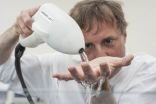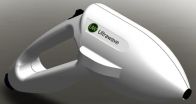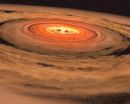(Press-News.org) Researchers from the University of Southampton have demonstrated how a pioneering ultrasonic device can significantly improve the cleaning of medical instruments and reduce contamination and risk of infection.
StarStream, invented and patented by the University of Southampton and in commercial production by Ultrawave Ltd., makes water more efficient for cleaning by creating tiny bubbles which automatically scrub surfaces. The device supplies a gentle stream of water through a nozzle that generates ultrasound and bubbles, which dramatically improve the cleaning power of water reducing the need for additives and heating.
Using just cold water, StarStream was able to remove biological contamination, including brain tissue from surgical steel. Cleaning instruments between patients is critical to avoid transmission of agents leading to conditions such as Creutzfeldt-Jakob Disease. It was also able to remove bacterial biofilms that typically cause dental disease and was effective at removing soft tissue from bones, which is required prior to transplants to prevent rejection of the transplanted material by the recipient's immune system.
Principal Investigator Professor Tim Leighton, from the University's Institute of Sound and Vibration Research, said: "In the absence of sufficient cleaning of medical instruments, contamination and infection can result in serious consequences for the health sector and remains a significant challenge. Our highly-effective cleaning device, achieved with cold water and without the need for chemical additives or the high power consumption associated with conventional strategies, has the potential to meet this challenge and transform the sector."
The research, published in the journal Physical Chemistry Chemical Physics, was funded by the Royal Society Brian Mercer Award for Innovation. The device has won numerous awards, including the 2014 'Best New Product of the Year' from S-lab and the 2012 Institute of Chemical Engineering Award for Water Management and Supply.
Professor Leighton added: "We are very grateful to the Royal Society Brian Mercer Fund (who granted their 2011 Award for Innovation jointly to myself and Dr Peter Birkin) for giving us the opportunity to use fundamental research to prove the effectiveness of StarStream?, whilst at the same time exploring ways to commercialise it. Commercialisation is vital: if we cannot build a business that can sell thousands of these to health providers at a price they find attractive, this invention will stay in the laboratory and help no-one."
INFORMATION:
The other contributors to the multidisciplinary study were Dr Peter Birkin, Dr Doug Offin and Dr Chris Vian (Chemistry, Faculty of Natural and Environmental Sciences), Dr Howlin and Dr Stoodley (National Centre for Advanced Tribology, Faculty of Engineering and the Environment), Dr Dawson and Professor Oreffo (Centre for Human Development, Stem Cells and Regeneration, Faculty of Medicine) and Dr Secker, Dr Hervé and Professor Keevil (Centre for Biological Sciences, Faculty of Natural and Environmental Sciences).
The team that conducted the study now forms the basis of the University's Network for Anti-Microbial Resistance and Infection Prevention (NAMRIP) Strategic Research Group, which hosts over 100 members under the chairmanship of Professor Leighton.
StarStream's effectiveness was further demonstrated with the publication of two additional papers - further results on its effectiveness against dental biofilms were published in the Journal of Dental Research, while the device's ability to clean skin models was published in Physical Chemistry Chemical Physics.
References:
Birkin P.R., Offin D.G., Vian C.J.B., Howlin R.P., Dawson J.I., Secker T.J., Hervé R.C., Stoodley P., Oreffo R.O.C., Keevil C.W. and Leighton T.G. (2015) Cold water cleaning of brain proteins, biofilm and bone - harnessing an ultrasonically activated stream. Physical Chemistry Chemical Physics, 17, 20574-20579 (doi: 10.1039/C5CP02406D).
Howlin R.P., Fabbri S., Offin D.G., Symonds N., Kiang K.S., Knee R.J., Yoganantham D.C., Webb J.S., Birkin P.R., Leighton T.G., Stoodley P. (2015) Removal of Dental Biofilms with a Novel Ultrasonically-Activated Water Stream. Journal of Dental Research, 94(9), 1303-1309 (doi:10.1177/0022034515589284).
Birkin, P.R., Offin, D.G., Vian, C.J.B. and Leighton, T.G. (2015) Electrochemical 'bubble swarm' enhancement of ultrasonic surface cleaning. Physical Chemistry Chemical Physics, 17(33), 21709-21715. (doi:10.1039/c5cp02933c). (PMID:26234563).
This news release is available in German.
Platinum is a great catalyst and can be used for many different applications. It's expensive stuff though, so tiny platinum nanoparticles sitting on cheap metal oxide materials are used to convert harmful carbon monoxide into carbon dioxide. Using scanning tunnelling microscopes, scientists at TU Vienna have now been able to image the catalytic behaviour of platinum sitting on iron-oxide, which allowed them to explain the process on an atomic scale. Surprisingly, the chemical reactions do not take place on the platinum ...
Researchers at the University of Birmingham have shown how the development of coated silica nanoparticles could be used in restorative treatment of sensitive teeth and preventing the onset of tooth decay.
The study, published in the Journal of Dentistry, shows how sub-micron silica particles can be prepared to deliver important compounds into damaged teeth through tubules in the dentine.
The tiny particles can be bound to compounds ranging from calcium tooth building materials to antimicrobials that prevent infection.
Professor Damien Walmsley, from the School of ...
This news release is available in German.
Topical research experiments are often too expensive or too complex to be rebuilt and incorporated in teaching. How can one, nevertheless, make modern science accessible to the public? This challenge was tackled in the research group Quantum Nanophysics led by Markus Arndt at the University of Vienna. For the first time, two research laboratories were created as complete, photorealistic computer simulations allowing university and high-school students as well as the general public to virtually access unique instruments. ...
EUGENE, Ore. -- (Sept. 16, 2015) -- New research at the University of Oregon finds that an organization's logo on a food product can trigger quick perceptions by consumers about an item's healthiness and influence their decision-making.
That perception also may be seen as an endorsement that may not exist, say study co-authors Elizabeth Minton of the University of Wyoming and T. Bettina Cornwell, the Edwin E. & June Woldt Cone Professor of Marketing in the Lundquist College of Business at the UO.
The research, led by Minton as part of her doctoral dissertation at the ...
TORONTO [11 September 2015] A team of astronomers has given us our best view yet of an exoplanet moving in its orbit around a distant star. A series of images captured between November 2013 to April 2015 shows the exoplanet β Pic b as it moves through 1 ½ years of its 22-year orbital period.
First discovered in 2008, β Pic b is a gas giant planet ten to twelve times the mass of Jupiter, with an orbit roughly the diameter of Saturn's. It is part of the dynamic and complex system of the star β Pictoris which lies over 60 light-years from Earth. The ...
The use of antidepressants during pregnancy has no long term neurodevelopmental or behavioural effects on the child, however they may be associated with an increased risk of postpartum haemorrhage, suggests the findings from three studies published in BJOG: An International Journal of Obstetrics and Gynaecology (BJOG).
Depression and anxiety are the most common mental health problems during pregnancy, with around 12% of women in the UK experiencing depression at some point during pregnancy and the postnatal period. The use of antidepressants such as selective serotonin ...
Stanford University School of Medicine researchers and their colleagues are calling for an urgent re-evaluation of global guidelines for the treatment of parasitic-worm diseases in light of a new study showing that large-scale treatment programs are highly cost-effective.
Parasitic-worm diseases afflict some 1.5 billion people in the developing world, causing gastrointestinal problems, anemia, wasting, and cognitive and growth deficits in children, and in some cases, liver, bladder and intestinal problems that can be fatal. About 150,000 people die of complications from ...
CANCER RESEARCH UK scientists have found how cells adapt to overcome cancer drugs designed to interfere with their genetic controls, according to a study* published today (Wednesday) in Epigenetics and Chromatin.
Normally molecular 'tags' are attached to DNA which send signals to the cell, telling it how to package its DNA and switch genes on or off.
Drugs called HDAC inhibitors cause a build-up of certain types of tags, leading to potentially damaging changes in gene activity that can kill cancer cells.
But while HDAC inhibitors can successfully treat certain types ...
An accidental find of a collection of young red dwarf stars close to our solar system could give us a rare glimpse of slow-motion planet formation.
Astronomers from The Australian National University (ANU) and UNSW Canberra found large discs of dust around two of the stars, tell-tale signs of planets in the process of forming.
"We think the Earth and all the other planets formed from discs like these so it is fascinating to see a potential new solar system evolving," said the lead researcher Dr Simon Murphy, from the ANU Research School of Astronomy and Astrophysics.
"However, ...
New research at the University of Warwick with colleagues from the London School of Economics has identified changes in the shape of rainfall across Europe; changes in the amount of drizzle compared with downpours and everything in-between.
Professor Sandra Chapman of the University of Warwick and co-authors Professor Nicholas Watkins and Dr David Stainforth from the London School of Economics have today published new research demonstrating how the variability in the way it rains makes it intrinsically difficult to identify the character of local climate change. Difficult ...






